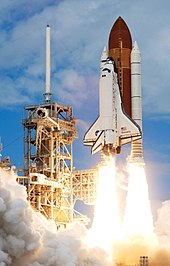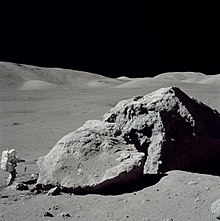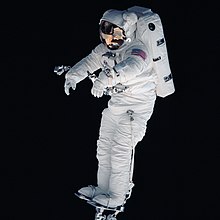
This is a list of NASA missions, both crewed and robotic, since the establishment of NASA in 1957. There are over 80 currently active science missions.[1]

This is a list of NASA missions, both crewed and robotic, since the establishment of NASA in 1957. There are over 80 currently active science missions.[1]
|
Main article: List of X-planes |
Since 1945, NACA (NASA's predecessor) and, since January 26, 1958, NASA has conducted the X-Plane Program. The program was originally intended to create a family of experimental aircraft not intended for production beyond the limited number of each design built solely for flight research.[2] The first X-Plane, the Bell X-1, was the first rocket-powered airplane to break the sound barrier on October 14, 1947.[3] X-Planes have set numerous milestones since then, both crewed and unpiloted.[4]
|
Main article: Human spaceflight |




NASA has successfully launched over 200 crewed flights. Three have ended in failure, causing the death of the entire crew: Apollo 1 (which never launched) in 1967 lost three crew members, STS-51-L (the Challenger disaster) in 1986, and STS-107 (the Columbia disaster) in 2003.
| Program | Start date | First crewed flight | End date | No. of crewed missions launched |
Notes |
|---|---|---|---|---|---|
| Mercury program | 1958 | 1961 | 1963 | 6 | First U.S. crewed program |
| Gemini program | 1961 | 1965 | 1966 | 10 | Program used to practice space rendezvous and EVAs |
| Apollo program | 1960 | 1968 | 1972 | 11[a] | Landed first humans on the Moon |
| Skylab | 1964 | 1973 | 1974 | 3 | First American space station |
| Apollo–Soyuz Test Project | 1971 | 1975 | 1975 | 1 | Joint with Soviet Union |
| Space Shuttle program | 1972 | 1981 | 2011 | 135[b] | First missions in which a spacecraft was reused |
| Shuttle-Mir program | 1993 | 1995 | 1998 | 11[c] | Russian partnership |
| International Space Station | 1993 | 1998 | Ongoing | 65 | Joint with Roscosmos, CSA, ESA, and JAXA; Americans flew on Russian Soyuz after 2011 retirement of Space Shuttle |
| Commercial Crew Program | 2011 | 2020 | Ongoing | 8 | Current program to shuttle Americans to the ISS |
| Artemis program | 2017 | 2025 (planned) | Ongoing | 0 | Current program to bring humans to the Moon again |
Notes:
|
Further information: Constellation program |
In May 2009, the Obama administration announced the launch of an independent review of planned U.S. human space flight activities with the goal of ensuring that the nation is on a vigorous and sustainable path to achieving its boldest aspirations in space. The review was conducted by a panel of experts led by Norman Augustine, the former CEO of Lockheed Martin, who served on the President's Council of Advisers on Science and Technology under both Democrat and Republican presidents.[5]
The "Review of United States Human Space Flight Plans" was to examine ongoing and planned National Aeronautics and Space Administration (NASA) development activities, as well as potential alternatives and present options for advancing a safe, innovative, affordable, and sustainable human space flight program in the years following Space Shuttle retirement. The panel worked closely with NASA and sought input from the United States Congress, the White House, the public, industry, and international partners as it developed its options. It presented its results on October 22, 2009.[6][7] [8]
In February 2010, Obama announced his proposal to cancel the Constellation program as part of his reform program. Constellation was officially canceled by the NASA Budget Authorization Act on October 11, 2010.
|
Further information: Artemis program |
NASA brought the Orion spacecraft back to life from the defunct Constellation program and successfully test-launched the first capsule on December 5, 2014, aboard EFT-1. After a near-perfect flight traveling 3,600 miles (5,800 km) above Earth, the spacecraft was recovered for study. NASA plans to use the Orion crew vehicle to send humans to deep space locations such as the Moon and Mars starting in the 2020s. Orion will be powered by NASA's new heavy-lift vehicle, the Space Launch System (SLS), which is currently under development.
Artemis 1 was the first flight of the SLS and was launched as a test of the completed Orion and SLS system.[9] During the mission, an uncrewed Orion capsule spent 10 days in a distant retrograde 60,000 kilometers (37,000 mi) orbit around the Moon before returning to Earth.[10] Artemis 2, the first crewed mission of the program, will launch four astronauts in 2025[11] on a free-return flyby of the Moon at a distance of 8,900 kilometers (5,500 mi).[12][13][14]
After Artemis 2, the Power and Propulsion Element of the Lunar Gateway and three components of an expendable lunar lander are planned to be delivered on multiple launches from commercial launch service providers.[15]
Artemis 3 is planned to launch in 2026[16] aboard an SLS Block 1 rocket and will use the minimalist Gateway and expendable lander to achieve the first crewed lunar landing of the program. The flight is planned to touch down on the lunar south pole region, with two astronauts staying there for about one week.[15][17][18][19][20]
|
Main category: NASA satellites orbiting Earth |
|
See also: Exploration of the Moon |
|
See also: Exploration of Mars |
|
Main article: List of NASA cancellations |